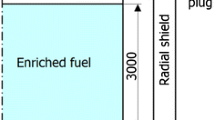Abstract
Optimization of fissile and fusile production in the SOLASE-H laser-fusion fissile-enrichment fuel-factory blanket is carried out. The objective is maximizing fissile breeding with the constraints of maintaining self-sufficiency in tritium production, and realistically accounting in the modeling for structural and coolant compositions and configurations imposed by the thermal-hydraulic and mechanical designs. The effect of radial and axial blanket zone thicknesses on fusile and fissile breeding is studied using a procedure which modifies the zones' effective optical thicknesses, rather than the actual three-dimensional geometrical configurations. A tritium yield per source neutron of 1.08 and a Th (n, γ) reaction yield per source neutron of 0.43 can be obtained in such a concept, where ThO2 Zircaloy-clad fuel assemblies for light water reactors (LWRs) are enriched in the233U isotope by irradiating them in a lead flux trap. This corresponds to 0.77 kg/[MW(th)-year] of fissile fuel production, and 1.94 years of irradiation in the fusion reactor to attain an average 3 w/o fissile enrichment in the fuel assemblies. For a once-through LWR cycle, a support ratio of 2–3 is estimated. However, with fuel recycling, more attractive support ratios of 4–6 may be attainable for a conversion ratio of 0.55, and of 5–8 for a conversion ratio of 0.70. These estimates are lower than those reported, around 20, for related designs.
Similar content being viewed by others
References
R. W. Conn et al., SOLASE-H, a laser fusion hybrid study, UWFDM-270, Fusion Research Program, University of Wisconsin (1979).
M. M. H. Ragheb, M. Z. Youssef, S. I. Abdel-Khalik, and C. W. Maynard, Three-dimensional lattice calculations for a laser-fusion fissile-enrichment fuel factory,Trans. Am. Nucl. Soc. 30(1978).
M. M. H. Ragheb, M. Z. Youssef, S. I. Abdel-Khalik, and C. W. Maynard, Lattice calculations and three-dimensional effects in a laser fusion-fission reactor,Nucl. Technol.,45:140 (September 1979).
M. M. H. Ragheb and C. W. Maynard, Monte Carlo statistical weighting methods for external-source-driven multiplying systems,Proc. Conf. on Computational Methods in Nuclear Engineering, Vol. II (American Nuclear Society, 1979).
C. W. Watson, Some Neutronics Features of an ICTR, inCentral Station Power Generation by Laser-Driven Fusion, LA-4858-MS, Vol. 1, L. A. Booth, compiler (Los Alamos Scientific Laboratory, 1972).
M. M. H. Ragheb, G. A. Moses, and C. W. Maynard, Pellet and pellet-blanket neutronics and photonics for electron beam fusion,Nucl. Technol. 48:16 (April 1980).
M. B. Emmett, The MORSE Monte Carlo radiation transport code system, ORNL-4972, Oak Ridge National Laboratory (1975).
MORSE-CG, RSIC Code Package CCC-203, Radiation Shielding Information Center, Oak Ridge National Laboratory (1976).
M. Z. Youssef, R. W. Conn, and G. A. Moses, “Burnup calculations for the laser driven fusion-fission fuel factory, SOLASE-H, UWFDM-264, University of Wisconsin (1978).
H. E. Bethe, The fusion hybrid,Phys. Today (May 1979),
C. E. Till and Y. I. Chang, Once-through fuel cycles, RSS-TM-13, Argonne National Laboratory (1978).
H. W. Groves, Jr.,Nuclear Fuel Management (John Wiley & Sons, New York, 1979), p. 295.
E. A. Eschbach, Some plutonium recycle program fuel cycles having reduced proliferation characteristics,Nucl. Technol. 41:109 (December 1978).
F. S. Martin and G. L. Miles,Chemical Processing of Nuclear Fuels (Butterworths Scientific Publications, London, 1958).
L. M. Lidsky, Fission-fusion systems: Hybrid, symbiotic and augeanNucl. Fusion 15(1975).
M. Z. Youssef and R. W. Conn, A survey of fusion-fission system designs and nuclear analyses, UWFDM-308, Fusion Research Program, University of Wisconsin (1979).
J. A. Maniscalco, L. F. Hansen, and W. O. Allen, Scoping studies of233U breeding fusion fission hybrid, UCRL-80585, Lawrence Livermore Laboratory (1978).
J. D. Lee, The beryllium/molten salt blanket—a new concept, UCRL-82663, Lawrence Livermore Laboratory (1979).
M. M. H. Ragheb, R. T. Santoro, J. N. Barnes, and M. J. Saltmarsh, Nuclear performance of molten salt fusion-fission symbiotic systems for catalyzed deuterium-deuterium and deuterium-tritium reactors,Nucl. Technol. 48:217 (1980).
M. M. H. Ragheb and C. W. Maynard, Three-dimensional cell calculations for a fusion reactor gas-cooled solid blanket,Atomkernenergie(ATKE) Bd. 32, Lfg. 3, 159 (1978).
Author information
Authors and Affiliations
Rights and permissions
About this article
Cite this article
Ragheb, M.M.H. Optimized fissile and fusile breeding in a laser-fusion fissile-enrichment flux trap blanket. J Fusion Energ 1, 285–298 (1981). https://doi.org/10.1007/BF01050361
Received:
Revised:
Issue Date:
DOI: https://doi.org/10.1007/BF01050361



